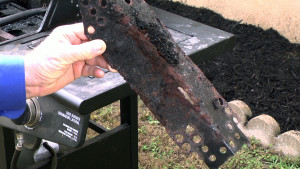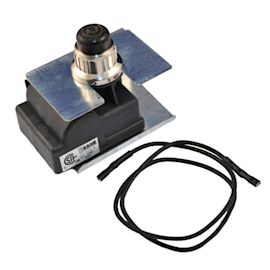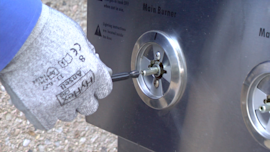How to prevent grease flare-ups on a gas grill video


If you’re seeing a lot of flare-ups while using your gas grill, it’s probably time to check the flame tamers and grease pan. This video from Sears PartsDirect shows how to make sure your grill's flame tamers and grease pan are clean and free of corrosion. Also, learn how to cook fatty meat and sausage to avoid dangerous flare-ups and out-of-control fires.
Check out our DIY Gas Grill Repair Help page for more troubleshooting advice, repair guides and grilling articles.
Supplies you might need
Grill brush
Soapy solution
Cloth
Container
Clean water
Fire extinguishing spray
Hi, Wayne here from Sears PartsDirect. Today we're going to talk about preventing those annoying and dangerous flare-ups that can happen on a gas grill.
Eliminate grease build-up on flame tamers
Flame tamers are your number 1 defense against flare-ups—if they’re clean. Flame tamers cover the grill burners and burn off grease as it drips onto the flame tamer. This burn-off creates smoke, which flavors the food you're grilling. But the flame tamers need to be relatively clean for that smoke to happen. If you let flame tamers collect grease, they can causing flare-ups instead of preventing them.
Clean dirty flame-tamers thoroughly before you preheat the grill. If you notice just a few drops of grease or light residue on the flame tamers when you're preparing to grill, preheat the grill to clean the flame tamers before cooking. To clean them when they're really dirty, pull off the grates and remove the flame tamers. Scrape off the big chunks of grease and food, and then use a grill brush to remove remaining residue. Wash the flame tamers with a cloth dipped in a mild solution of grease-cutting dishwashing liquid and water. Rinse the flame tamers with clean water and then reinstall the flame tamers and grates.
Replace any rusted or damaged flame tamers. Grease can build up on rust, causing a flare-up. Rust holes in the flame tamers let grease drip directly on the burners, which also can cause a flare-up or even a fire.
Check grease pan for residue and clean
Another source of flare-ups is too much grease and debris in the grease pan below the burners. Old, dried grease left in the drain pan will liquefy, vaporize and then burn as the grill heats up. Check the grease pan before firing up your grill and clean it if you find heavy residue.
The grease pan on this grill is removable so I can pull it out and clean it thoroughly. If your grill doesn't have a removable grease pan, remove the grates, flame tamers and possibly the burners to thoroughly clean the bottom of the burner box or the grease pan. Replace the grease pan if you find severe corrosion or damage such as rust holes during cleaning.
How to avoid flare-ups with fatty meat
Fatty meat can also cause flare-ups. Flame tamers can only burn off a reasonable amount of fat drippings, so trim excess fat from meat before cooking to help avoid flare-ups.
These tips will help you prevent flare-ups. But what do you do if your grill is already on fire? You can close the lid to smother a small flare-up. For large flare-ups, pull the meat off the grill or move it so it can cook with indirect heat.
What’s that, you ask? It's an area on your grill where you leave a burner or two off so meat roasts on heat from the adjacent lit burners when you close the lid. An indirect heating area won't produce the searing heat that can start a fire.
You should only cook some meats such as fatty sausage or untrimmed pork roast over indirect heat because flame tamers can only tame a reasonable amount of fat drippings. Cooking fatty meats above direct flames can cause extreme flare-ups. Before you position the meat over indirect heat, you usually need to heat the meat or sausage over direct heat to initially increase the internal temperature. Watch the meat closely and quickly move it to the indirect heat as soon as it drips fat. When heated, some sausages squirt fat and juices out, creating a flamethrower effect. Keep a close eye on your grill when cooking fatty sausages and meats to prevent an uncontrollable fire.
Keep fire extinguisher on hand
Here's one final tip. Always keep a CO2 fire extinguisher handy when grilling. You never know when a fire can grow out of control. Use a CO2 fire extinguisher on grill fires rather than water because CO2 safely extinguishes and smothers grease fire flames. Water, on the other hand, will spread a grease fire.
I hope this video helps you out. You can finds links to the items we talked about in the video description below. Check out our other videos here on the Sears PartsDirect YouTube channel. Subscribe and we’ll let you know when we post new ones.
Symptoms for gas grills
Choose a symptom to see related gas grill repairs.
Main causes: nearly empty fuel tank, faulty pressure regulator, burner tube clogs, bad burner tube alignment to gas valv…
Main causes: empty fuel tank, tripped flow-limiting device on the pressure regulator, faulty manifold valves, burner tub…
Main cause: worn wheel…
Main causes: damaged or dirty flame tamers, corroded firebox, accumulated grease and debris in the grease pan…
Main causes: clogged burner tubes, cracked insulators on igniter electrodes, wiring failures, bad ignition module, manif…
Repair guides for gas grills
These step-by-step repair guides will help you safely fix what’s broken on your gas grill.

How to replace a gas grill wheel
Replace a broken or damaged wheel in less than 15 minutes.…

How to replace a gas grill igniter electrode
Replace the igniter electrode on your gas grill if it won’t light the burner.…

How to replace a gas grill ignition module
Follow these steps to replace the ignition module if it doesn't produce a spark. …
Articles and videos for gas grills
Use the advice and tips in these articles and videos to get the most out of your gas grill.

Learn about all the convenient features on our Sears PartsDirect website that make your parts purchases easier.…

Get answers to frequently asked questions about Sears and Sears PartsDirect.…

A conversion kit and a few simple tools are all you need.…